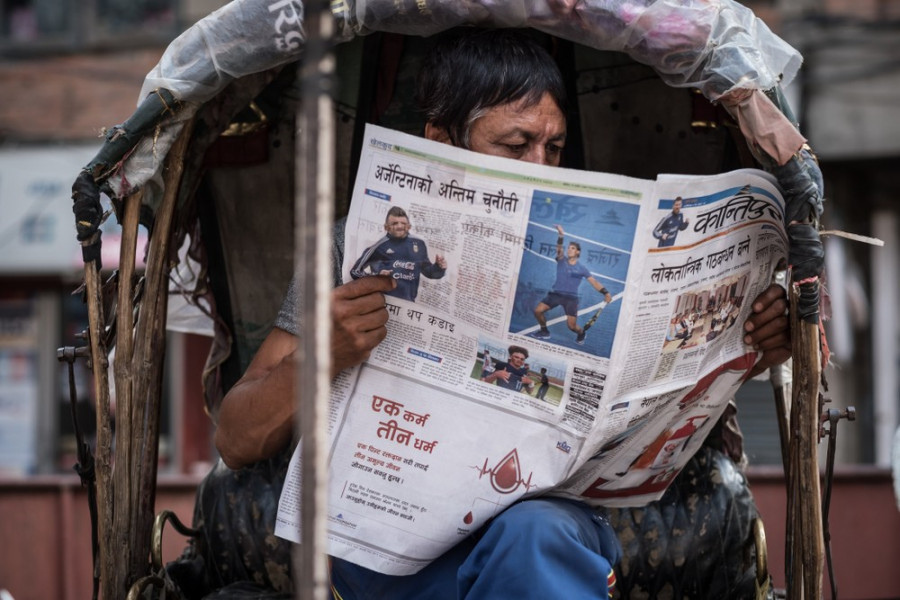Columns
Media literacy in Nepal
People lack awareness about digital media issues, including online privacy, security and misinformation.
Umesh Pokharel
Media literacy empowers individuals to critically analyse the complex media landscape, enabling informed decision-making and fostering active societal participation. Unfortunately, the Government of Nepal, media houses, civil society organisations and media development organisations don’t prioritise it. As a result, media literacy is thinly referenced in our legislative framework. The Constitution of Nepal 2015 articulates the right to opinion and expression (Article 17[2a]), the right to communication (Article 19), and information (Article 27) while not mentioning the phrase. However, these provisions indirectly advocate for media literacy. Similarly, the National Mass Communications Policy 2016, without using the phrase, indirectly calls for actions promoting the same. For instance, Objective 1.1 of the National Mass Communications Policy seeks to create a civilised and prosperous society by ensuring accountable mass media based on democratic principles and the right to freedom of expression. This involves integrating media literacy through promoting access to diverse information sources and promoting critical thinking skills.
Critical thinking
The National Census of Nepal 2021 (2078 BS) records Nepal's literacy rate at 76.3 percent, with disparities in literacy levels among different geographic regions, castes, creeds and ethnicities. The literacy rate itself tells about the status of media literacy in Nepal.
Most of the population tends to accept media information at face value, lacking the ability or inclination to analyse its content critically. A section of the population, comprising social activists, media workers, teachers, businesspersons and professionals, applies critical lenses to the media’s content. Various factors influence media content, including ownership, advertising, political ideology, philosophical inclinations, diversity of media workers, corporate interests and soft power dynamics. In research for his Master of Philosophy thesis, Govinda Dhital has written that headteachers in secondary schools demonstrate high levels of media literacy across seven dimensions: Access, retrieval, understanding, use/communication, analysis, evaluation and creativity.
The audience's response and feedback to media content also serve as indicators of media literacy. However, this engagement seems to have diminished over the past decade. Interestingly, scandals and gossip about political leaders and celebrities and stories related to love, sex and failed social relationships still receive engagement from the audience, especially on social media. Notably, short, entertaining videos on platforms like TikTok often garner more interaction than in-depth investigative news reports despite the latter requiring significant resources and efforts to produce.
Another indicator of the general population's critical awareness is the extent to which people file complaints about media performance. According to the Press Council Nepal’s database, 221 complaints were registered against the media in 2079-80 BS (2022-23), compared to 203 complaints registered in the PCN in 2078-79 BS (2021-22) and 192 in 2077-78 BS (2020-21).
Evaluating content
Most people find it challenging to evaluate the credibility and reliability of various media sources, a critical aspect of media literacy. Many are unaware of the potential biases or affiliations of media houses with corporate entities, power holders or the government. For instance, during the Covid-19 pandemic, individuals took health decisions based on misleading information, exemplifying the lack of source evaluation skills. This led to a surge in the acquisition of Vitamin D capsules, giloy (gurjo) herbs and turmeric.
People also fail to understand media techniques like framing, editing and using language or images to manipulate or sway opinions, indicating a low level of media literacy. During the campaign for the 2022 parliamentary elections in Nepal, social media users disseminated doctored photographs of politicians and exploited out-of-context video clips to confuse voters. Additionally, a 2021 study by Media Action Nepal found that out of 49,051 news articles surveyed, 1,817 contained false or misleading information.
Ownership and influence
Understanding the commercial and political interests that may influence media content, including recognising when content is sponsored or influenced by advertisers or special interests, is another indicator of media literacy. This, too, is low among the majority of the audience. However, social activists, media professionals, educators, businesspersons and other professionals understand this dynamic. Anecdotal evidence from my conversation with them in several parts of the country reveals that some individuals actively cross-check information from local FM stations, as they can readily identify which stations are supportive to which political parties.
Formats and genres
An important aspect of media literacy involves distinguishing between various types of media content, such as news, entertainment, advertising and opinion pieces and understanding the conventions and purposes of each. Unfortunately, many individuals struggle with this distinction. For instance, there are cases where people mistake a reputable news channel for an unfamiliar YouTube channel or perceive personal social media posts from journalists as official news from their respective organisations. This confusion extends to content creators, the audience cannot tell non-professional producers from professionals. The emergence of television personalities and journalists as YouTubers has led to further confusion, with their content being taken for official programming from their former television networks.
Awareness about the unique aspects of digital media, including issues related to online privacy, security, digital footprints and the spread of misinformation online, is also minimal in Nepal. Access to digital security training and tools for media outlets and content producers in Nepal is limited, leaving them vulnerable to cyber threats. Moreover, most people lack awareness about the ethical responsibilities of media producers and consumers, including privacy, consent, intellectual property and the impact of media consumption on individuals and society.
Media literacy efforts
Despite the government's lack of prioritisation of media literacy, a few government institutions and non-governmental organisations have taken steps to strengthen it. For instance, the Federation of Nepali Journalists (FNJ) has initiated media literacy programmes mostly tailored to journalists. The Press Council Nepal (PCN) conducts interactive programmes on digital literacy that align with its objectives. Certain municipalities have also organised media skills training programmes that incorporate media literacy.
Moreover, political parties and local governments have launched initiatives to guide their members on effective media relations. Furthermore, secondary school curricula include topics such as media introduction, the importance of communication, media and entertainment, information technology, digital technology, and cyber-security. These efforts collectively contribute to bolstering media literacy across various sectors of society.
It is necessary to enhance media literacy in Nepal by integrating media literacy initiatives into the legislative framework and the national plan of action, including the periodic plan. Education and training programmes on media literacy must go beyond the circle of journalists. Moreover, it is imperative to promote critical thinking skills among media consumers via targeted programmes in partnership with academic institutions, government entities and civil society organisations.




 12.12°C Kathmandu
12.12°C Kathmandu













%20(1).jpg&w=300&height=200)

